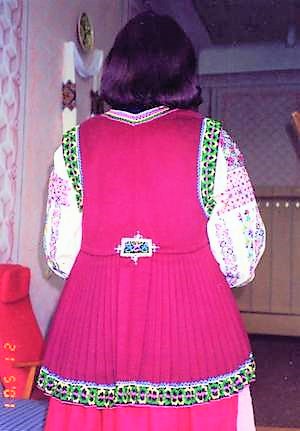Hello all,
Today I will talk about a costume which seems to be restricted to one village; Serafyntsi in Horodenka district, Pokuttia, Ukraine. This village of a couple thousand people lies in the southeast of Horoden'ka district, in the easternmost part of Ivano-Frankiwsk Oblast, not far from the Dnister. Here is a map showing the location of Horodenka district.
In some features, this costume is typical for Horodenka district, and in others it is unique.
The image at the head of this article is of a painting by Ivan Honchar, who did much work on Ukrainian folk costume and embroidery, especially in central and eastern Ukraine. Compare the painting with this photograph of Hanna Luchytska, taken in 1902.
The basic garment, as everywhere in Ukraine, is an embroidered chemise. The ustawka, or shoulder piece, is set in parallel to the body, and is gathered together with the front and back fields into the neck. The sleeve embroidery follows the three part canon common to the region from Podillia down to Moldova. The shoulder piece has dense embroidery, often in horizontal stripes, the upper sleeve has a more monochromatic strip, usually done in brick stitch, and the lower sleeve has vertical stripes of embroidery. The collar, cuffs and hem are also embroidered.
Although the embroidery is executed in many colors, shades of red predominate. Here, three shades of red predominate in the embroidery. The shoulder is done in Holbein stitch, which, if done with heavy thread, becomes curly stitch, in which texture is expressed rather than outline.
In this example the central monochrome band is a very pale yellow. Note that there are also stripes of embroidery edging the shoulder piece, on the edges of the body piece, and on the front to either side of the opening.
Here is a more colorful example. The range of colors used is increasing in recent years.
As you can see here. The birds were taken from graphed designs from western Europe.
Some newer examples are very full of color.
As in most places, older women tend to wear darker colors.
Old photographs mostly seem to show a gathered floral print skirt and apron, as here, in contrast to the wrap around overskirt obhortka, which was worn in neighboring villages. Ivan Honchar painted an apron with horizontal woven ornament, but I have found no images of that kind of apron being worn with this costume, although it was worn in neighboring villages.
This village also has another garment which is called 'riklya'. This is a skirt with an attached bodice, which, while not unknown in Ukrainian costume, is rare. The riklya is generally made from solid colored cloth. These apparently were sometimes worn without aprons.
The vest is unique to this village. In general lines it is similar to the kersetka of central and eastern Ukraine, but here is called horsyk. Also the front opens in the center and does not overlap. It is, however, longer than vests that one usually sees in western Ukraine, and is very full in back. Here is Kul'chytska's drawing of this costume.
The horsyk has ornamented bands around the neck, the hem, and the armholes. They are usually decorated with interwoven bands of rickrack, and some embroidery.
The back has a box pleat in the center, and then the skirt part is pleated to either side.
There is an embroidered ornament in the center back just above the seam.
Necklaces were, of course worn here, as everywhere in Ukraine.
You can see multiple views of this garment at Krovets'
https://krovets.com.ua/uk/nagrudniy-odyag/kersetka
For cooler weather, or perhaps for older women, they wore a jacket that was made exactly the same way but had sleeves.
https://krovets.com.ua/uk/verhniy-odyag/kabat-zhinochiy
Here is another sketch by Kul'chytska showing the jacket.

Today you see older women wearing kerchiefs, but traditionally married women put their hair up and wore a cap, over which a long cloth was wrapped. This cloth is usually called peremitka or namitka, but in this village was simply called rushnyk. It had woven ornament on both ends.
Just a few more images of this costume.
Thank you for reading, I hope that you have found this to be interesting and informative.
Roman K.
email: rkozakand@aol.com
Roman K.
email: rkozakand@aol.com



































thank you this was wonderful information as by family is from this village. where did you find the great photos?
ReplyDeleteMy grandparents were from this village. Thank you for sharing this! Do you have any patterns for the garments and embroidery?
ReplyDeleteThe embroidery and the cut of the garments is clearly shown in the illustrations. If you mean paper patterns, no such thing exists.
DeleteWow,so Very interesting,Thank You for the Education.
ReplyDeleteKanarya Adaları yurtdışı kargo
ReplyDeleteKanada yurtdışı kargo
Kamerun yurtdışı kargo
Kamboçya yurtdışı kargo
Jersey yurtdışı kargo
7BDZH
this is beautiful. my great grandfather lived in Serafince/Serafyntsi (Boyuk/Bojuk)
ReplyDeleteЯ в такому однострої виступала в Серафинецькому клубі. Тепер хочу придбати таку вишиванку і горсик.
ReplyDelete